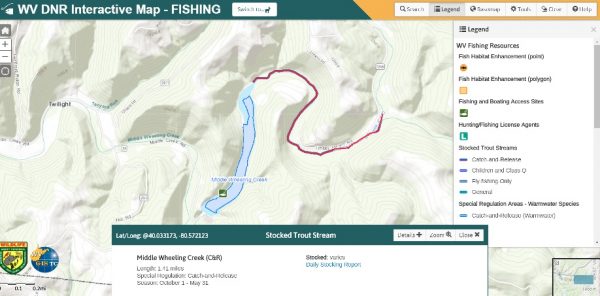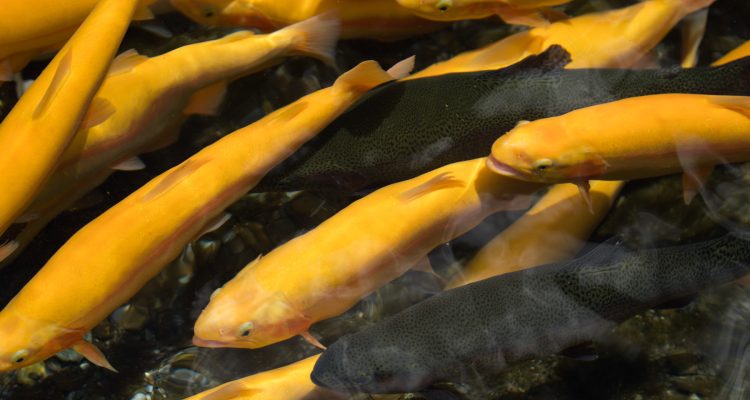Winter in West Virginia can feel like a lifetime. The clouds roll in to stay, the snow flies, and we spend our hibernating months looking out the window, wishing we were outside again, doing sunny-weather things. But there’s one breed of outdoorsman who sneaks out of the house about half-past January, undaunted by the frigid temps and the bleakness of the season: the trout fisherman. Trout fisherman hit the water early. They stand in 34-degree water up to their thighs, hip waders pulled over layers of long underwear, casting in the snow.
And they love it.
West Virginia boasts fantastic trout fishing, but most of it can be found in the mountains. The North Fork of the South Branch of the Potomac, the Elk River and the Cranberry are three noteworthy streams, but trout are a West Virginia passion. Even here in the northern panhandle, we’ve got trout opportunities.
Just one species of trout is native to West Virginia: the brook trout. Brookies only thrive in the coldest streams with the purest, cleanest water. They’re small, rarely longer than 10 inches, and they’re struggling in our state due to water pollution. You’ll find them down in the mountains. Here in Ohio County, we’ve got our own trout, thanks to the stocking efforts of the West Virginia Department of Natural Resources (DNR). Each year, beginning in January and ending in the spring, the DNR unloads buckets full of trout into our state’s waterways. The fish you’ll catch in our area will be rainbow trout and brown trout, as well as the golden trout. The golden is a mutation of the rainbow trout; it’s still a rainbow but displays a bright yellow color rather than the traditional rainbow pigment.
This year, state natural resource officials have organized a “West Virginia Gold Rush.” From April 2-6, at 30 locations in the state, they’ll be stocking only golden trout. The DNR has noticed that kids aren’t fishing as much as they used to, and the gold rush is intended to spark a renewed interest in fishing among young people. Anglers, especially young ones, love golden trout.
There are seven coldwater hatcheries in the state. Most are located in the eastern mountains, and together they produce 750,000 pounds of trout each year to be distributed in 200 streams and waterways. We’ve also got a federal fish hatchery run by the U.S. Fish and Wildlife Service in White Sulpher Springs. They raise rainbow trout eggs that are shipped to other regional hatcheries.

The West Virginia DNR won’t tell readers when or where they’ll be stocking ahead of time, but if you follow their website (www.wvdnr.gov), they’ll update right after the stocking. Their public records indicate a stocking in Middle Wheeling Creek on Jan. 19. Middle Wheeling Lake (into which Middle Wheeling Creek flows) was stocked on Feb. 27 and March 15. It will continue to be stocked every other week through May. Lower Wheeling Creek was stocked on March 7 and will continue to be stocked on the same schedule. Other local trout streams include Buffalo Creek in Brooke County and Kings Creek in Hancock County. Anglers can check out the DNR’s new interactive trout map on the website to help them locate a stocked stream. The map also indicates whether, like Middle Creek, a stream is catch-and-release.
Trout stocking sounds like a delicate art. The way I envision it, a shiny vehicle backs down to the water’s edge and, one by one, the trout are gently guided into the river with well wishes and a kiss. Reality is vastly different. What actually happens is more of a trout dump. They go from truck to bucket to river, whether it’s from a bridge or the shoreline. Wildlife officials quite literally chuck them in. And off the trout go, as the fisherman eagerly await the official release update.
Ben Pockl is one such local, avid fisherman. He grew up here and fished with his dad. Though he fishes at Piedmont Lake, he spends a great deal of time in Ohio County fishing for trout in the early spring. He obtained a degree in Wildlife and Fisheries from WVU, so he knows about the ecology of the trout and their habitat. He’s one of the fishermen you see in the snow.
“Usually after the first stocking, the first day I have off, I go,” he said.
Pockl prefers fishing in the creek over the lake.
“I mostly fish Big Wheeling Creek,” he said. “I like the stream aspect of trout fishing more than the lake aspect. The stream is their natural habitat. If the weather stays pretty cool you can go all the way up to early June, if the streams stay cool enough. Usually, at the beginning of May, I’ll start bass fishing. I end my trout season around May 1.”
Pockl explained that trout cannot survive in warm water. As the calendar progresses, they either die or find their way to the river, where they become part of the food chain. The fish rarely go to waste, though. The DNR has a good idea about the demand for trout in a particular stream; they raise and stock the waterways so that their supply meets that demand.
Pockl fishes with a spinning reel using power bait or live bait like mealworms or nightcrawlers. In terms of artificial lures, he might try an inline spinner or a spoon.
Trout aren’t just a fly fisherman’s game, but fly fishing is a popular pastime and a common way to trout fish. Using a fly rod in the east isn’t as simple as it is out in the wide-open spaces of the west. Here, underbrush grows along the bank and mature trees hang over the streams. There’s a reason why the fly fisherman is stereotypically calm, quiet and relaxed: they have to be. With several tens of feet of line out at a time, an angler has serious snag potential. Even in the winter, the bare branches hang low and make life difficult. To reach the trout, who prefer to feed in the riffles and eddies, you’ve got to get out from under the shoreline vegetation. Hence the need for hip- and chest-waders, as well as a Type B personality. It’s a game of calculation and patience. Fly fishermen aren’t just there for the fish — they’re seeking an outdoor experience.
For locals who might want to introduce their kids to fly fishing, or who might want to try it themselves, the employees in the fly fishing department at Cabela’s possess a thorough knowledge of both the sport and the area. When I wanted to get into fly fishing before my kids were born, I went up there and stood around looking confused. Quickly, Bill Haberfield, the expert in the fly fishing department, arrived. By the time I left, I had a fly rod appropriate for my size and skill, the proper flies that matched what the trout were eating at that point in the season, and a lesson on how to tie flies and cast. If you don’t know where to begin, the guys there can help. On a quiet morning, you may even be invited to the parking lot to try a few casts.
The trout is a dignified fish. It’s a challenge to hook and a thrill to land. The trout legacy in West Virginia is a long one, and trout fishermen consider each fish a privilege to encounter. Thanks to the efforts of West Virginia wildlife officials, we can sneak out the back door in early spring and seek these beautiful creatures.
• Laura Jackson Roberts is a freelance writer in Wheeling, W.Va. She holds an MFA in Creative Writing from Chatham University and writes about nature and the environment. Her work has recently appeared in Brain, Child Magazine, Vandaleer, Animal, Matador Network, Defenestration, The Higgs Weldon and the Erma Bombeck humor site. Laura is the Northern Panhandle representative for West Virginia Writers, a blog editor for Literary Mama Magazine and a member of Ohio Valley Writers. She recently finished her first book of humor. Laura lives in Wheeling with her husband and their sons. Visit her online at www.laurajacksonroberts.com.




